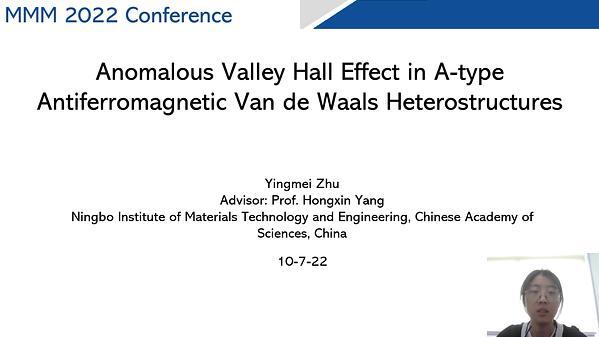Would you like to see your presentation here, made available to a global audience of researchers?
Add your own presentation or have us affordably record your next conference.
Recent spintronics revealed that the intrinsic anomalous Hall effect (AHE) emerged from an interplay between the Berry curvature and the spin-orbit coupling. Because the Berry phase theory does not require a spontaneous magnetization for AHE (1), AHE can be applied to antiferromagnetic (AFM) materials. Recently, we reported the hysteresis of AHE voltage as a function of magnetic field for the Pt/AFM-Cr2O3/Pt trilayer (2). The observed AHE should not be simply interpreted because Cr2O3 is an insulator, and we proposed the spin chiral texture in the energy bands as an origin (3). To address the insight of AHE, the correlation with the magnetization is helpful (1), which is difficult for Cr2O3 due to its AFM nature. To address this issue, the spontaneous magnetization is induced in the Cr2O3 thin film by Al doping (4) and investigated the correlation with AHE.
Pt(2 nm)/Al-doped Cr2O3(200 nm) bilayer was fabricated on α-Al2O3(0001) substrate by a DC magnetron sputtering. Al was doped by the cosputtering with Cr in the Ar and O2 mixed gas. Composition ratio was determined by XRF: Al/Cr = 4/96. Structural characterizations revealed that each layer grew in Pt(111)/(Al,Cr)2O3(0001). Magnetization was measured by VSM. AHE was measured using the Hall device fabricated by photolithography and Ar ion milling.
Fig.1 shows the M-H curve and the AHE loop at 200 K for the perpendicular magnetic field. The spontaneous magnetization, ~18 emu/cc is similar to the previous report (4). Loops show the rectangular hysteresis showing the perpendicular magnetic anisotropy. Reversal fields are similar for two loops. Temperature dependences of the remanent magnetization Mr and the remanent anomalous Hall resistivity σxy are shown in Fig.2. Although Mr monotonically decreases with increasing temperature, σxy first increase, show the maximum and decrease again. The similar temperature dependence of σxy was reported for other systems where the AHE is associated with the Berry phase. This similarity supports the Berry phase origin of AHE at the Pt/Cr2O3 interface.
References:
(1) N. Nagaosa, J. Sinova, S. Onoda, et al., Rev. Mod. Phys. 82, 1539 (2010).
(2) X. Wang, K. Toyoki, R. Nakatani, Y. Shiratsuchi, AIP Advances, 12, 035216 (2022).
(3) T. Moriyama, Y. Shiratsuchi, T. Ono et al., Phys. Rev. Appl. 13, 034052 (2020).
(4) T. Nozaki, M. Al-Mahdawi, Y. Shiokawa, et al., Phys. Status Solidi RRL, 12, 180036 (2018).

